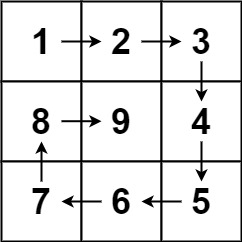Leetcode 59 Spiral Matrix II
 Jessie Yu
Jessie Yu
Given a positive integer n, generate an n x n matrix filled with elements from 1 to n^2 in spiral order.
Example 1:

Input: n = 3
Output: [[1,2,3],[8,9,4],[7,6,5]]
Example 2:
Input: n = 1
Output: [[1]]
Constraints:
1 <= n <= 20
Understanding the Problem:
The problem statement asks for a function that, given a positive integer n, generates an n x n matrix filled with elements from 1 to n^2 in a spiral order. To tackle this problem efficiently, it's crucial to comprehend the nature of the spiral traversal within the matrix.
To identify recurring patterns, consider that any n x n square can be traversed in a circular manner, consisting of four sides: top, left, right, and bottom. The number of such circular traversals, or "loops," can be determined by n/2. For odd values of n, the middle number requires special handling.
For instance, in a 3 x 3 square:
# Given 3 * 3 Square, rotate in spiral order
- TOP
[0, 0] = 1; [0, 1] = 2;
- RIGHT
[0, 2] = 3; [1, 2] = 4;
- BOTTOM
[2, 2] = 5; [2, 1] = 6;
- LEFT
[2, 0] => 7; [1, 0] = 8;
- MIDDLE
[1, 1]
Finding the solution
The solution utilises the above understanding to systematically fill the matrix in a spiral order. By iteratively traversing the four sides of each loop and incrementally filling the matrix with integers, the algorithm constructs the desired spiral matrix efficiently.
const generateMatrix = function(n) {
let loop = Math.floor(n / 2);
let mid = Math.floor(n / 2);
let count = 1;
let offset = 1;
let x = 0;
let y = 0;
let result = new Array(n).fill(0).map(() => (new Array(n).fill(0)));
while (loop--) {
let col = y;
let row = x;
//TOP
for (; col < n - offset; col++) {
result[row][col] = count++;
};
//RIGHT
for (; row < n - offset; row++) {
result[row][col] = count++;
};
//BOTTOM
for (; col > y; col--) {
result[row][col] = count++;
};
//LEFT
for (; row > x; row--) {
result[row][col] = count++;
};
x++;
y++;
offset++;
}
if (n % 2 !== 0) {
result[mid][mid] = n * n;
};
return result;
}
Complexity analysis
Each of the four loops iterates n - offset times. The total number of loops is n/2.
Therefore, the worst-case time complexity of this solution is O(n^2).
Conclusion
In conclusion, the provided algorithm efficiently generates a spiral matrix by systematically traversing the matrix in a spiral order and filling it with consecutive integers. By understanding the underlying pattern of traversal and employing systematic loop operations, the algorithm achieves the desired functionality within a time complexity of O(n^2).
Subscribe to my newsletter
Read articles from Jessie Yu directly inside your inbox. Subscribe to the newsletter, and don't miss out.
Written by

Jessie Yu
Jessie Yu
Passionate developer from the land down under 🐨. Crafting clean and efficient code to solve real-world problems. With a keen eye for detail and a knack for problem-solving, I thrive in turning ideas into robust software solutions. Let's build something incredible together! #DeveloperLife #CodeCrafting"